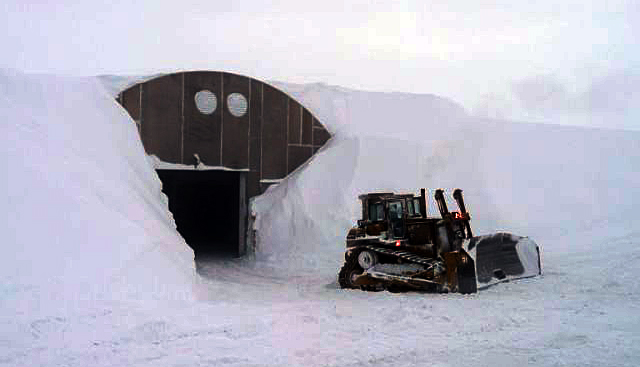|
South Pole Station Archives - 2009 South Pole population swells as main season beginsPosted November 6, 2009
Summer has officially begun at South Pole Station 
Photo Credit: Dr. Ella Derbyshire/Antarctic Photo Library
The Basler aircraft arrives at South Pole on Oct. 19, bringing the first summer people to the station.
But the faces weren’t entirely new to the winter-overs; many of the first passengers are seasoned veterans of South Pole life. Members of the community gathered in the dining hall to welcome old friends back and also to eat the first fresh fruit seen on station since last February. Incoming executive chef James Brown scheduled each of the first few planes to bring a few boxes of delicious fresh food, including bananas, kiwi fruit, plums, apples, fresh eggs and more. The summer arrivals have brought fresh energy to the station, and work began immediately on making it ready for the larger Hercules LC-130 aircraft operated by the New York Air National Guard Before then, the “First Flight Festival” was held Saturday night, Oct. 24, with more than three hours of live music. The festival is a way for the winter-overs to display their talents and welcome the new arrivals. Summer and winter personnel mingled in the gym during the show, and a penguin piñata provided comic relief for everyone. The winter staff eagerly snatched up the candy inside the piñata. “I haven’t had a Starburst in over a year,” exclaimed one gleeful employee. The musical slate for the evening was just as exciting as the candy, with the women’s a cappella group “The Polecats” opening the show, followed by a variety of single-song performances by solo, duet, or trio groups, and closing with our two main winter rock bands: “The Rookies” and “April the Leukemic Cat.” Highlights of the show included an ensemble piece with piano, vocals, drums, guitar, bass, violin and trumpet, and a solo guitar performance by engineer Nathan Greenland of his song about life at the South Pole during the winter. Now that the festival is over, the winter-overs are ready to step aside and allow the new summer talent to take over. Scientists Erik Shirokoff and Ross Williamson report that this winter was a record season for the South Pole Telescope (SPT) Sunlight returns to the bottom of the worldPosted October 9, 2009
The sun is finally above the horizon at the South Pole for the first time in six months. We celebrated the occasion with the traditional “sunrise dinner” on the weekend of the equinox. The South Pole Station The sunrise festivities were a welcome diversion from the flurry of activity of the previous week. A late winter storm set wind records of as high as 48 miles per hour for Sept. 10-12. The sustained winds left behind record snowdrifts. More than six feet of snow covered the massive double doors in front of the garage arch after the storm, and the storm almost completely buried the Logistics Arch. The Martin A. Pomerantz Observatory (MAPO), home of many astrophysical projects, also suffered severe drifting and heavy equipment had to excavate part of the site. According to meteorologist Kristina Shiroma, sunrise is a particularly stormy season for Pole. This is due to a greater heat imbalance between the interior and the coasts, as the sea ice starts melting each spring. Cold air from the interior mixes with warmer air on the coasts, creating larger storms, which the jet stream pushes toward the interior. Other than cleaning up after the storm, members of the South Pole winter-over crew are busy preparing for the coming summer season. The first planes since Feb. 16 are due to arrive on Oct. 12 — Kenn Borek’s Basler BT-67 and Twin Otter airplanes, flying all the way from Canada to McMurdo with a stop at South Pole — and there is much to do before they arrive. Opening activities include warming up buildings that have been cold during the winter, creating a skiway and fuel pit for the planes, digging out drifted buildings, staging materials for construction crews to use when they arrive, and preparing rooms in the station for new occupants. Since the return of the sun, research associates Jonathon Miller and Robert Fuhrmann have been shutting down their winter aurora and atmospheric experiments, and putting them away for the summer months. They can simply power down some of these winter-only experiments for the summer; others need to be covered for protection or even disassembled and stored. However, the geological experiments that Jonathon and Robert monitor (including seismometer and magnetometer equipment) continue to collect data year-round. [See previous article: MacGyvers of polar science.] Out at the Atmospheric Research Observatory (ARO), NOAA South Pole air is the cleanest in the world, and scientists use the samples as a baseline measurement for air taken from other locations. Once summer arrives, these air samples will head to three main locations: the Commonwealth Scientific and Industrial Research Organization Sun begins its journey to the horizon but temps remain coldPosted September 4, 2009
Winter is rapidly coming to an end here at South Pole Station 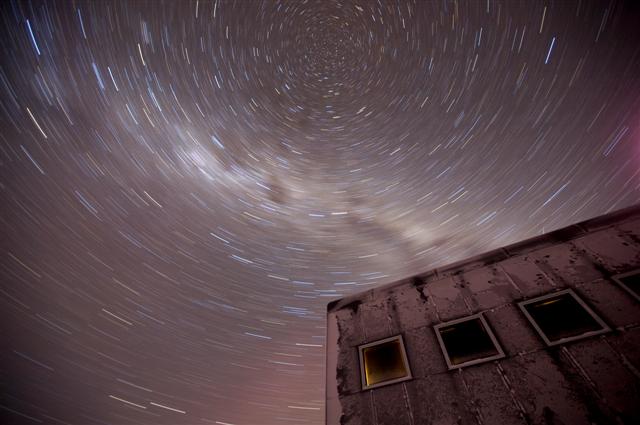
Photo Credit: Patrick Cullis/Antarctic Photo Library
The impending sunrise at South Pole means the spectacular night sky, like in the photo above, has begun to fade.
In one of the longest running projects of the winter, the lighting in the new Logistics Arch (LO) is almost finished, with only a few installations remaining. [See related story: South Pole Storage.] The workhorse behind this enormous project — 150 lights and more than 60,000 feet of wire — has been electrician Monty Myrtle. Monty insists he couldn’t have completed the project without the folks who volunteered to give him a hand throughout the winter. In celebration of the accomplishment, about half of the station population attended a lighting ceremony down in the LO, complete with root beer floats for everyone. With August also comes the return of light from the sun. Erik Shirokoff, grantee with the South Pole Telescope Aug. 1 brings astronomical twilight to the Pole, meaning the sun is greater than minus 18 degrees below the horizon, and the dimmest stars start disappearing. Aug. 21 is the beginning of nautical twilight, with the sun at minus 12 degrees. Sept. 7 marks the beginning of civil twilight, and with the sun at minus 6 degrees, all but the brightest stars will have disappeared. Then, around Sept. 21, we will look to the horizon for our first glimpse of the sun in six months. These first signs of sunlight have caused mixed emotions among the current South Pole winter-over crew. Many have expressed surprise at seeing sunlight again, saying it seems too early for the darkness to be disappearing. Others lament the loss of the beautiful auroras, Iridium flares, and starlight skies that we have all enjoyed this winter. But for most, the light on the horizon is a welcome sight, spurring many to dream of post-Ice travels and reunions with friends and family. 
Photo Credit: Patrick Cullis/Antarctic Photo Library
A Scott tent sits next to the ceremonial pole while an aurora shimmers in the background and the Milky Way shines above.
But so far, the August sun has not brought the South Pole any extra warmth. According to meteorologist Kristina Shiroma, August has been the coldest month of the winter with nine days below minus 90 degrees Fahrenheit, and the coldest temperature of this winter (minus 98.0 degrees) occurred on Aug. 17 and 18. The cold temperatures have hampered a few projects, such as the delivery of materials for LO rack construction or the changing out of waste bins, since such work requires the use of heavy equipment that cannot operate in extremely cold weather. But on days when the weather slips into the acceptable range for heavy equipment, there is always a flurry of activity, and people pitch in to help get the most use out of the equipment before the weather changes again. The warmer days have kept heavy equipment operator Boyd Brown extra busy, sometimes working late into the night or getting up early in the morning in order to take advantage of the warm temperatures. Soon, however, temperatures will rise, along with the work tempo as the summer field season arrives. Polies enjoy fresh veggies in dark of winterPosted May 8, 2009
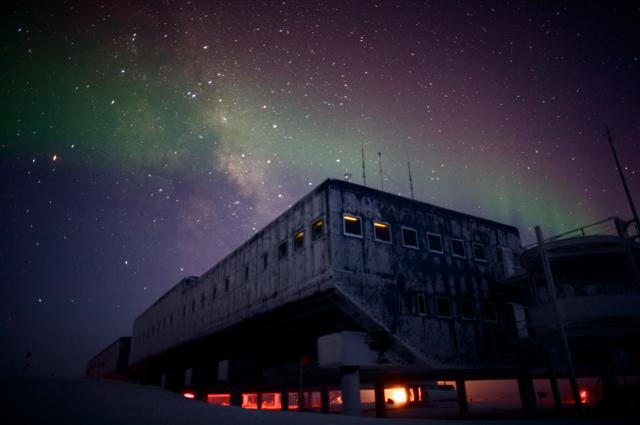
Photo Credit: Patrick Cullis/Antarctic Photo Library
Aurora shimmers in the night sky over South Pole Station.
As the South Pole winter moves toward its fourth month, the crew of 43, the smallest in a decade, has settled into a regular work schedule that provides maintenance for the station, troubleshooting, and scientific observation. The big story at South Pole Station The recent meteor shower peaked April 22, and appeared to come from the constellation Lyra, the harp, which is below our horizon. According to research done by our station doctor, Ella Derbyshire, these shooting stars are made of small dust particles left behind from the passage of Comet Thatcher. They heat up as they enter the atmosphere, and a few of them leave lingering, faintly glowing trails. The Lyrid shower Auroras “When this stream of electrons and protons impacts with our atmosphere, they excite the various gases, releasing excess energy that appears as light moving in shapes across the night sky. “The 11-year solar cycle affects the frequency and brilliance of the aurora we see. The sun is currently close to its solar minimum, producing a slight zephyr of particles. During the next five to six years, the sun’s activity will increase, culminating in large coronal mass ejections, which will light up the night sky with increasingly powerful aurora. Nevertheless, even with the sun at a minimum, the power and beauty of the aurora is still impressive here at the South Pole — a wonderful display.” 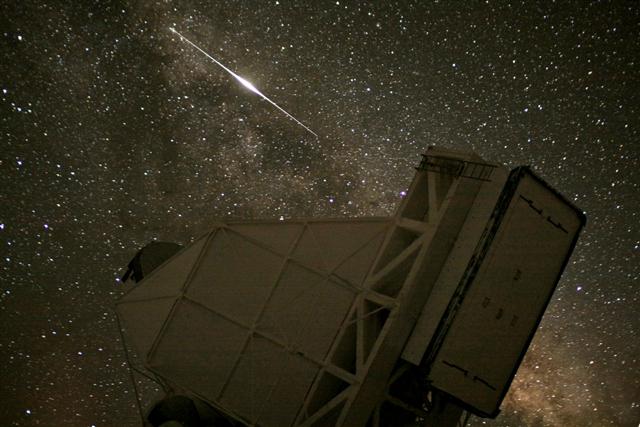
Photo Credit: Keith Vanderlinde/Antarctic Photo Library
An Iridium flare appears above the South Pole 10-meter Telescope.
Iridium flares “During the brief period when one of these panels is aligned so as to reflect sunlight to an observer, the satellite appears much brighter than usual,” he says. “The satellites are normally just barely visible to the naked eye, but can outshine the brightest stars in the sky during one of these 20-second flares.” Shirokoff adds that the satellites are 800 kilometers above the surface of the Earth, and even as it seems dark as night to our eyes from the ground, the airborne equipment can be in direct sunlight when the sun is below our horizon. Indoors, the South Pole Growth Chamber 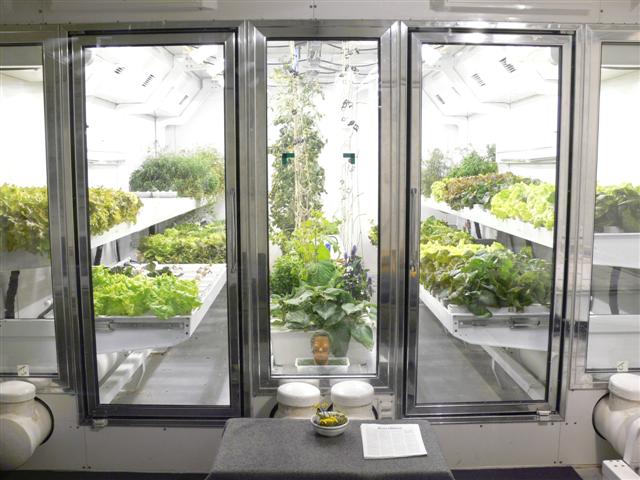
Photo Credit: Lane Patterson/Antarctic Photo Library
The South Pole Growth Chamber uses artificial lighting and hydroponics to grow fresh vegetables.
Joseph Romagnano, who, with a PhD in Crop Physiology from Utah State University (and refers to himself as Greenhouse Joe, South Pole Farmer) oversees the chamber, which is on the cutting edge of hydroponic technology. According to Joe, the chamber is constantly in the experimental stage, and is something we might someday see on space colonies where there is no natural sunlight, earth-like soil, or moderate outdoor temperatures — very much like conditions at Pole. In the first nine weeks of the 2009 winter, the greenhouse produced close to 340 pounds of freshies for the station. That means the crew enjoys newly harvested greens almost every night. The most prolific growers are lettuces, cucumbers, jalapeno peppers, basil and dill, but we have also enjoyed beautiful chard, mizuna, arugula, and even a handful of the first tiny, sweet Alpine strawberries, a first for the growth chamber, which was built during the winter of 2004. Some other crops are still growing and are expected to yield cilantro, bell peppers, the edible flower nasturtium, watermelon, and cantaloupe, among others. Smallest crew winters at South Pole since 1999Posted March 16, 2009
The onset of winter at South Pole 
Photo Credit: Dr. Ella Derbyshire/Antarctic Photo Library
South Pole construction workers William J. Stiner and Todd Adams install siding on the roof of the elevated station.
The last plane for the summer season left the flight on Feb. 16. It was still warm — about minus 39 degrees Fahrenheit — but since then, temperatures have several times reached 50 below, the line at which hydraulics can freeze, making flying impossible for most larger aircraft. A crew of 43 — the smallest group to winter at the South Pole in 10 years — is now family for the next eight months. Winterizing the station requires special tasks in every sector. About 2,000 feet of fuel hose had to be rolled in from the ice, a project that took 12 volunteers two-and-a-half days. Six volunteers spent seven hours removing the flags that that mark the skiway and approach signals over a five- to six-mile area so they don’t blow away during upcoming winds. In food services, triwall boxes of supplies were moved from the outside snow berms to the protection of the old Dome station, so material specialists won’t have to venture too far during dark months when the thermometer can hit minus 100 degrees Fahrenheit. There are ongoing projects slated for the 2009 season. Currently, two carpenters are working to install siding on the roof of the elevated station. Due to the extreme environment, it will take two to three times longer to complete than urban construction. 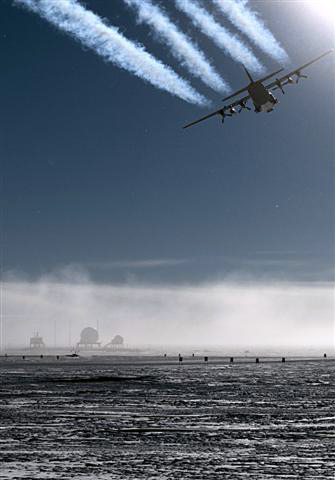
Photo Credit: Eric Shirokoff/Antarctic Photo Library
Last flight of the 2008-09 summer season leaves South Pole.
Strapped in safety harnesses on top of the building about 50 feet from the ground, they work in an exposed space where 20-knot winds surge by unhampered. Yet despite wind chills that drop the temperature to 90 below, the carps are already ahead of schedule. Over this austral winter, the South Pole Telescope On top of all this, each South Pole winter resident has a side job that addresses safety concerns — working the fire, trauma, logistics, or communications teams to keep the people, station, and outlying buildings from any mishap. They participate in regular trainings and drills to remain sharp and ready to handle any situation that could arise. The winter-over crew this year has a few returning Polies, and also many new staff members. Yet what is consistently remarkable in this tiny corner of the world is the extraordinary community spirit. Everyone — from the station doctor to the head of the facilities, engineering, maintenance and construction department — has a day of dish pit duty every six weeks, a nine-hour shift supporting the dining area by making beverages, vacuuming floors, cleaning tables and, of course, washing dishes. On top of this, every resident has house mouse duties to keep the station tidy, and often volunteer for morale activities, whether it is working in the store, baking bagels, creating a lounge area, hosting a film festival, starting a musical band, or teaching a class. Overall, Polies intend to make the intense experience of wintering here the best it can be. We look forward to a season of accomplishments as well as a lot of fun. |
Home /
Around the Continent /
South Pole Station Archives - 2009
"News about the USAP, the Ice, and the People"



For USAP Participants |
For The Public |
For Researchers and EducatorsContact UsU.S. National Science FoundationOffice of Polar Programs Geosciences Directorate 2415 Eisenhower Avenue, Suite W7100 Alexandria, VA 22314 Sign up for the NSF Office of Polar Programs newsletter and events. Feedback Form |

